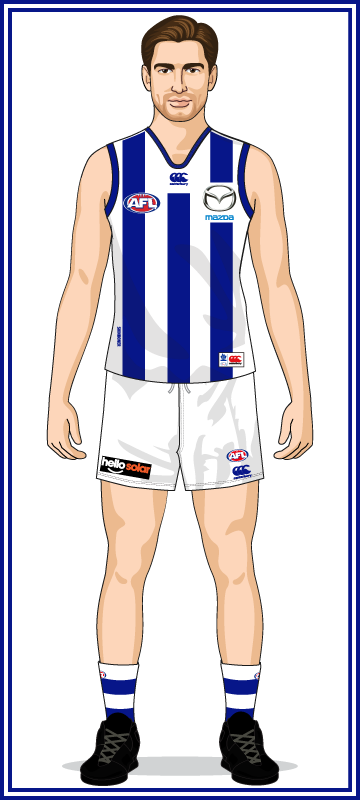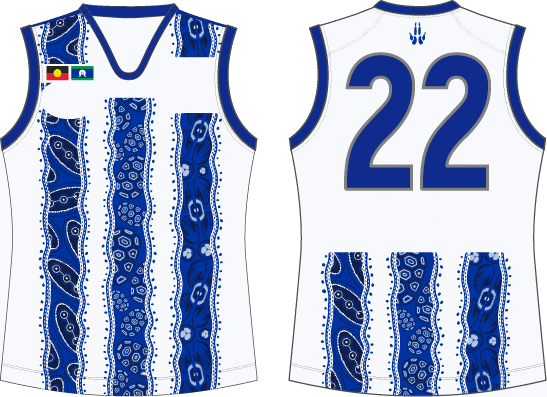North Melbourne Football Club
the kangaroos
The North Melbourne Football Club is the fourth oldest football club in the AFL.
It is also one of the oldest sporting clubs world-wide.
founded
1869
nickname
The Shinboners
North
The Kangaroos
Motto
Victoria Amat Curam
victory demands dedication
The 1880s marked the emergence of the modern identity now associated with North.
Four years later the club adopted the traditional uniform of blue and white vertical stripes at the insistence of the VFA, who wanted a visible contrast between Geelong's and Hotham's uniforms.
The third significant development occurred in 1888 with the club returning to its original name of the North Melbourne Football Club. This followed the name of the local area reverting from Hotham to North Melbourne.
After three attempts, 29 years of waiting and numerous other applications to enter the VFL, finally North was rewarded for its persistence with admittance to the League in 1925. Even then, the opportunity was almost lost as the League delegates debated into the early hours of the morning on which clubs should be invited to join the intake.
It was only after much deliberation that North Melbourne's name was eventually substituted for Prahran's making North "the lucky side" of the invitees that included Footscray and Hawthorn. North Melbourne was forced to change its uniform to avoid a clash when it joined the VFL.
playing uniform




The club was connected to the St Mary's Church of England Cricket Club, whose colours – blue and white – are reflected in the colours today.
club song
So join in the chorus,
And sing it one and all,
Join in the chorus,
North Melbourne's on the ball,
Good old North Melbourne,
They're champions you'll agree,
North Melbourne is the team that plays to win for you and me.
The words North Melbourne
changed when the club was competing as The Kangaroos
.
home ground
In 1882 the club moved into the North Melbourne Recreation Reserve (Arden St Oval), which remains the home of the club today.
Arden Street Oval
In 1882 the club moved into the Arden Street Oval, which remains the home of the club today.
Docklands Stadium
It plays its home matches at Docklands Stadium.
Bellerive Oval
It also plays matches at Blundstone Arena, in Bellerive, a suburb on the eastern shore of Hobart, Tas.
In 1985 North Melbourne pioneered the concept of playing football on Friday nights. Since then they have played the most Friday night games of any AFL club.
The VFA grew to 13 senior clubs in the 1890s. Led by Geelong and Essendon, the largest clubs of the VFA formed the Victorian Football League, in 1896. Despite finishing 6th in 1896, North Melbourne was not invited to the breakaway competition.
North continued on in the depleted VFA, emerging as a powerhouse, finishing 2nd in 1897, 1898 and 1899. In 1903, after 34 years of competing, the club won its first premiership, defeating Richmond in the final. The club became back‑to‑back premiers in 1904 after Richmond forfeited the grand final due to the appointment of an umpire whose performance when the two teams met earlier in the year was severely criticised by Richmond players and officials.
North merged with fellow VFA football club West Melbourne in 1907, which at the time had lost its home ground. The joint venture saw a chance of promotion, and the club applied for admission to the more prestigious VFL in 1908, but Richmond and University were admitted instead. North was kicked out of the VFA during the 1907/08 offseason as a result of applying to join the VFL, before the local community reestablished the North Melbourne Football Club under a new committee, successfully enabling the club to play in the VFA in the 1908 season.
North Melbourne were cellar dwellers for its first twenty-five years of VFL membership and struggled to win matches in the superior VFL competition, but by the late 1940s had developed a strong list and significant supporter base. In 1949 North secured the VFL Minor Premiership, finishing top of the ladder at the end of the home-and-away season with 14 wins and 5 losses. They failed to make the Grand Final that year (eventually won by Essendon), but in 1950 they did reach the final, defeated by a more efficient Essendon. It was in this year that the club adopted the "Kangaroos" mascot.





















